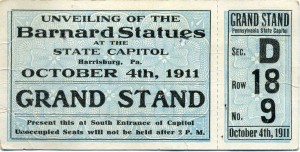The Barnard statues
American sculptor George Grey Barnard was born in Pennsylvania and raised in Illinois before studying art in Paris. He received a commission in 1902 to produce sculptures for the new Pennsylvania State Capitol in Harrisburg and moved back to Paris to start work.
Barnard’s sculptures–Love and Labor: The Unbroken Law and The Burden of Life: The Broken Law, flanking the front entryway–were unveiled in a public ceremony on October 4, 1911. The dedication ceremony was quite an affair, with an invocation by Barnard’s father, poem and song, a performance by the Commonwealth Band, an acceptance by Pennsylvania governor (and former Major Leaguer) John Tener, and an address by former Pennsylvania governor Samuel Pennypacker. It was quite a day in the history of the commonwealth.
 Evidently, somebody in my family was there to see it. Maybe it was Grace Patterson, maybe it was JJ Patterson and his wife Beulah, maybe it was Beulah’s father SE Pannebaker. I don’t know who it was. But found among the papers were a folded one-sheet program for the event (folded so small and so tattered that it could have easily been mistaken for a scrap and tossed) and two tickets, punched but with stubs intact, for grandstand seats at the unveiling. My family members, whoever they were, sat in section D, row 18, seats 8 and 9.
Evidently, somebody in my family was there to see it. Maybe it was Grace Patterson, maybe it was JJ Patterson and his wife Beulah, maybe it was Beulah’s father SE Pannebaker. I don’t know who it was. But found among the papers were a folded one-sheet program for the event (folded so small and so tattered that it could have easily been mistaken for a scrap and tossed) and two tickets, punched but with stubs intact, for grandstand seats at the unveiling. My family members, whoever they were, sat in section D, row 18, seats 8 and 9.
George Barnard’s career continued, buoyed by the success of his statues in Harrisburg. He died in 1938, at age 74, while working in New York City. And although he had never lived in Harrisburg, he was interred at Harrisburg Cemetery in Allison Hill, wishing to be buried in the state of his birth, close to the works that defined his career.

